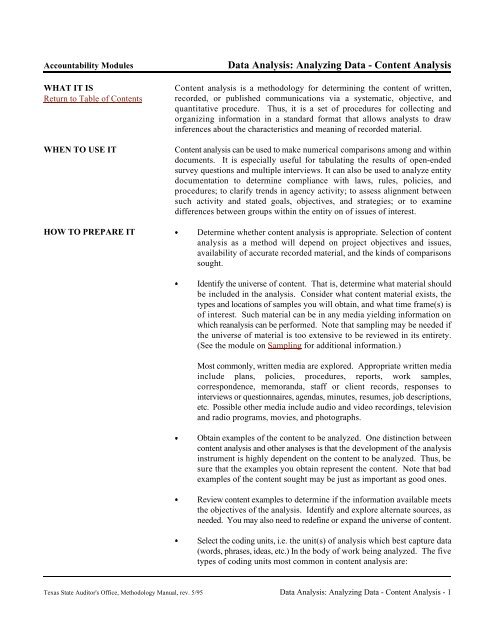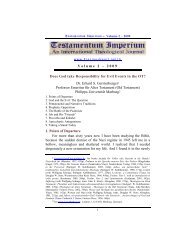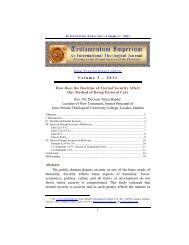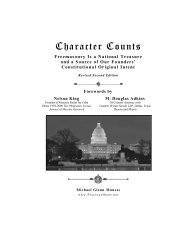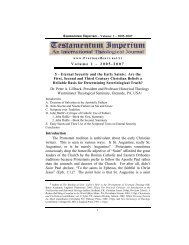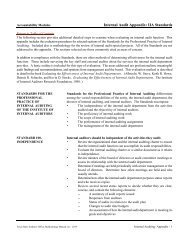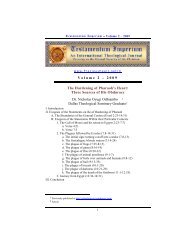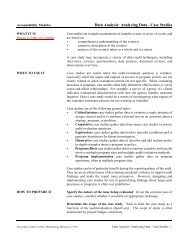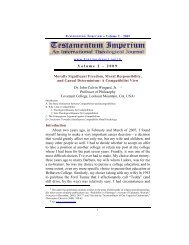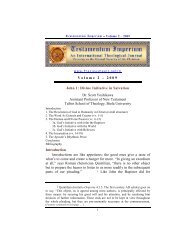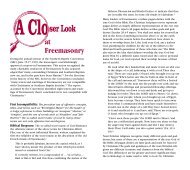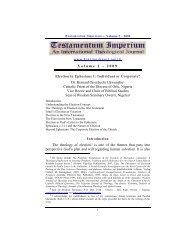Data Analysis: Analyzing Data - Content Analysis - PreciousHeart.net
Data Analysis: Analyzing Data - Content Analysis - PreciousHeart.net
Data Analysis: Analyzing Data - Content Analysis - PreciousHeart.net
Create successful ePaper yourself
Turn your PDF publications into a flip-book with our unique Google optimized e-Paper software.
Accountability ModulesWHAT IT ISReturn to Table of <strong>Content</strong>sWHEN TO USE IT<strong>Data</strong> <strong>Analysis</strong>: <strong>Analyzing</strong> <strong>Data</strong> - <strong>Content</strong> <strong>Analysis</strong><strong>Content</strong> analysis is a methodology for determining the content of written,recorded, or published communications via a systematic, objective, andquantitative procedure. Thus, it is a set of procedures for collecting andorganizing information in a standard format that allows analysts to drawinferences about the characteristics and meaning of recorded material.<strong>Content</strong> analysis can be used to make numerical comparisons among and withindocuments. It is especially useful for tabulating the results of open-endedsurvey questions and multiple interviews. It can also be used to analyze entitydocumentation to determine compliance with laws, rules, policies, andprocedures; to clarify trends in agency activity; to assess alignment betweensuch activity and stated goals, objectives, and strategies; or to examinedifferences between groups within the entity on of issues of interest.HOW TO PREPARE IT C Determine whether content analysis is appropriate. Selection of contentanalysis as a method will depend on project objectives and issues,availability of accurate recorded material, and the kinds of comparisonssought.CIdentify the universe of content. That is, determine what material shouldbe included in the analysis. Consider what content material exists, thetypes and locations of samples you will obtain, and what time frame(s) isof interest. Such material can be in any media yielding information onwhich reanalysis can be performed. Note that sampling may be needed ifthe universe of material is too extensive to be reviewed in its entirety.(See the module on Sampling for additional information.)Most commonly, written media are explored. Appropriate written mediainclude plans, policies, procedures, reports, work samples,correspondence, memoranda, staff or client records, responses tointerviews or questionnaires, agendas, minutes, resumes, job descriptions,etc. Possible other media include audio and video recordings, televisionand radio programs, movies, and photographs.CCCObtain examples of the content to be analyzed. One distinction betweencontent analysis and other analyses is that the development of the analysisinstrument is highly dependent on the content to be analyzed. Thus, besure that the examples you obtain represent the content. Note that badexamples of the content sought may be just as important as good ones.Review content examples to determine if the information available meetsthe objectives of the analysis. Identify and explore alternate sources, asneeded. You may also need to redefine or expand the universe of content.Select the coding units, i.e. the unit(s) of analysis which best capture data(words, phrases, ideas, etc.) In the body of work being analyzed. The fivetypes of coding units most common in content analysis are:Texas State Auditor's Office, Methodology Manual, rev. 5/95 <strong>Data</strong> <strong>Analysis</strong>: <strong>Analyzing</strong> <strong>Data</strong> - <strong>Content</strong> <strong>Analysis</strong> - 1
<strong>Data</strong> <strong>Analysis</strong>: <strong>Analyzing</strong> <strong>Data</strong> - <strong>Content</strong> <strong>Analysis</strong>Accountability Modules— Words, the smallest possible unit. Key words are easily identifiedand are generally reliably classified by different content analysts.However, words can have different meanings in different contexts.— Themes, the next larger unit. A theme may be a simple sentence orsingle idea. Though thematic analysis is commonly used, it can bequite difficult, particularly when the material analyzed containscomplex passages. The problem is basically one of reliability.That is, if two content analysts were to divide content using thesame thematic unit, they might easily disagree on where thedivisions should be made.— Character, in which the content is divided each time a person orobject is mentioned. This analysis unit is quite useful foridentifying relationships and spans of control between individualswithin the entity.— Item, i.e. the whole unit in which the content was originallygenerated. For example, if one were analyzing responses to openendedquestions, the entire response might be the item. Itemanalysis is useful when variations within items are small orunimportant. If the item becomes too complex, another coding unitshould be considered.— Space-and-time measures which relate to the amount of space ortime displaced by the content. Examples include number of pages,column inches in periodicals, number of minutes in audio or videorecordings, number of frames in movies, etc.Note that one need not be limited to one coding unit. It may often beappropriate to use more than one unit on the same content to get atdifferent issues of interest. Moreover, note that while choosing the codingunit precedes selecting the coding categories, selecting coding categoriesmay require changing the coding unit(s). Finally, be aware that the unitof analysis is important later when quantitative inferences are made aboutthe nature and scope of the content analyzed.CDevelop coding categories. <strong>Content</strong> analysis stands or falls by itscategories, just as a questionnaire stands or falls by its questions.Category systems can be roughly divided into two classes -- those dealingwith what is said and those dealing with how it is said. Good categorysystems are:— exhaustive, so that all relevant content can be categorized— mutually exclusive, so that data can be placed in one and only onecategory— independent, so that the assignment of data to one category doesnot affect the assignment of other data to a categoryDeveloping coding categories, along with the actual coding of contentinformation, is the most important part of content analysis. Among otherkey considerations are that:<strong>Data</strong> <strong>Analysis</strong>: <strong>Analyzing</strong> <strong>Data</strong> - <strong>Content</strong> <strong>Analysis</strong> - 2 Texas State Auditor's Office, Methodology Manual, rev. 5/95
Accountability Modules<strong>Data</strong> <strong>Analysis</strong>: <strong>Analyzing</strong> <strong>Data</strong> - <strong>Content</strong> <strong>Analysis</strong>— Issues related to the objectives of the analysis should be developedand listed.— If a large number of issues exist, it may be helpful to roll them upinto more general categories.— One should develop codes for different reactions to the issueswhich meet the above requirements. This may often resemble arating system for responses. Here it is important that contentcoders rate each coding unit separately on each of the differentcategories or variables. For example, the SAO conducts an openendedsurvey of Child Protective Services field staff to determi<strong>net</strong>heir assessment of available automation. The following tableindicates a possible coding scheme:ISSUE AGREE DISAGREE DON’T KNOW1. Adequacy of automationAdequateNeeds improvementInadequate2. Availability of automationAvailability is limitedThis table, although simplistic, provides an example of quantifying andscaling responses. The level of scaling can be more or less detailed.More detail (such as adding "strongly agree" or "strongly disagree")allows for more specific analysis but can complicate reliability.CCode the material. Conduct a pre-test of the suitability of the categories,the coding instructions, and the reliability of coding among coders. It isquite common that changes, additions, or deletions are needed incategories, coding units, content universe, or even objectives. Additional,previously unforeseen issues may also surface. Given these problems,pre-testing the content analysis system is generally needed.Since a primary reason for content analysis is to collect objectiveinformation, it is important that the procedure is consistently applied.This consistency is called interrater reliability and refers to the degree towhich multiple coders yield identical results. Assessing reliability isextremely important in content analysis, given the high potential forsubjective interpretation of responses by those performing the codingfunction. This problem increases as response scales are developed tomeasure intensity (e.g., strongly agree, somewhat agree, neither agree nordisagree, somewhat disagree, strongly disagree). Such intensity scalesTexas State Auditor's Office, Methodology Manual, rev. 5/95 <strong>Data</strong> <strong>Analysis</strong>: <strong>Analyzing</strong> <strong>Data</strong> - <strong>Content</strong> <strong>Analysis</strong> - 3
<strong>Data</strong> <strong>Analysis</strong>: <strong>Analyzing</strong> <strong>Data</strong> - <strong>Content</strong> <strong>Analysis</strong>Accountability Modulesrequire coders to make often minor distinctions in interpreting the databeing analyzed.Determining coding reliability is a two-stage process. First, one mustensure that the classification system is understood and applied to eachunit separately. Then, one must compare how multiple coders classify asample of the same material. Ideally, units of analysis would receive thesame categorization by different coders. This may not be the case,however. The acceptable range of reliability is generally 80 to 100percent. This means that two independent coders would code a group ofitems exactly the same at least 80 percent of the time. This is alsodetermined during the pre-test of the system on a sample of the content tobe analyzed. Low reliability should be investigated and may arise from:— unclear definition of categories— incompetent coders— inadequate coder training— inadequate instructions on the use of codes or categories— unclear or overly subtle distinctions between categories— substandard media (e.g., illegible text, poor quality audio, etc.)The following table provides some sample responses to questions aboutthe adequacy of automation issue discussed above. The reader shouldconsider how he or she might code them.Question: How would you assess the level of automation in your office?# 21 Overall, the system is pretty good. The information we have access tois very helpful. But, updates to the data base are batch processed. Ifthe system allowed real-time updates this would give case workersmore up-to-date information.# 22 The terminals hurt my eyes. They are hard to look at for long periodsof time. The system is very slow retrieving information, and much ofthe information we get is miscoded or incorrect. Terminal time is alsolimited because of frequent down time for repairs. I can't say thecurrent system helps me much in doing my job.# 23 There is a serious lack of printers. Case workers need to be able toprint out information on our terminals, but this is time consumingbecause we all have to send output to one printer. Lots of days theprinter is offline for repairs which complicates the situation.<strong>Data</strong> <strong>Analysis</strong>: <strong>Analyzing</strong> <strong>Data</strong> - <strong>Content</strong> <strong>Analysis</strong> - 4 Texas State Auditor's Office, Methodology Manual, rev. 5/95


